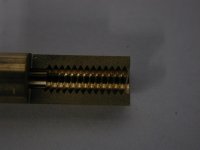implmex
Diamond
- Joined
- Jun 23, 2002
- Location
- Vancouver BC Canada
Hi All:
I've been handed a turning task that's giving me fits.
Internal 60 degree Vee thread 0.400" full threads long, 2 threads max lead out.
Pitch 0.03125"
Max diameter 0.146" +/- 0.001"
Root diameter 0.104" or 0.105" +/- 0.0003, 32 microinch or better
Pitch diameters 0.1235", 0.1245". 0.1256" and 0.1270" no tolerance specified.
Material 360 leaded brass. (Thank God for small mercies at least!)
Here's my problem:
When I run my threading bar (yeah it's TINY) the chips sometimes pack in between the bore and the side of the bar and scarf up the root diameter a bit, even though I've broken up the threading cycle into 6 separate cycles so I can fish out and blow out the chips frequently
So if I bore to 0.103", thread it, and then bore my finish diameter of 0.104" it doesn't clean up everywhere.
If I pre-bore to 0.100" I can't get a strong enough single pointing bar in to go 0.460" deep; there's just no space in there to accommodate the thread profile depth and the retract.
The thread crest is only 0.0024" wide at the root diameter...it's so damned delicate I can scarf it up just looking at it wrong or fishing out a chip too aggressively.
So I made up some custom taps to try that.
No joy on the taps, they scarf up the root even worse.
The problem is I have no room for clearance at the root of the biggest tap; it's currently a 0.001" radius which makes my root diameter of the tap 0.104" and it was the Devil's very own to get it that small.
Single pointing it and then chasing it with the taps makes no difference...I'll get a good one and then three crappy ones in a row.
So I'm looking for a fresh idea before I tell the customer I can't make his parts.
Someone send me a brilliant new strategy please!!
Cheers
Marcus
Implant Mechanix • Design & Innovation > HOME
Vancouver Wire EDM -- Wire EDM Machining
I've been handed a turning task that's giving me fits.
Internal 60 degree Vee thread 0.400" full threads long, 2 threads max lead out.
Pitch 0.03125"
Max diameter 0.146" +/- 0.001"
Root diameter 0.104" or 0.105" +/- 0.0003, 32 microinch or better
Pitch diameters 0.1235", 0.1245". 0.1256" and 0.1270" no tolerance specified.
Material 360 leaded brass. (Thank God for small mercies at least!)
Here's my problem:
When I run my threading bar (yeah it's TINY) the chips sometimes pack in between the bore and the side of the bar and scarf up the root diameter a bit, even though I've broken up the threading cycle into 6 separate cycles so I can fish out and blow out the chips frequently
So if I bore to 0.103", thread it, and then bore my finish diameter of 0.104" it doesn't clean up everywhere.
If I pre-bore to 0.100" I can't get a strong enough single pointing bar in to go 0.460" deep; there's just no space in there to accommodate the thread profile depth and the retract.
The thread crest is only 0.0024" wide at the root diameter...it's so damned delicate I can scarf it up just looking at it wrong or fishing out a chip too aggressively.
So I made up some custom taps to try that.
No joy on the taps, they scarf up the root even worse.
The problem is I have no room for clearance at the root of the biggest tap; it's currently a 0.001" radius which makes my root diameter of the tap 0.104" and it was the Devil's very own to get it that small.
Single pointing it and then chasing it with the taps makes no difference...I'll get a good one and then three crappy ones in a row.
So I'm looking for a fresh idea before I tell the customer I can't make his parts.
Someone send me a brilliant new strategy please!!
Cheers
Marcus
Implant Mechanix • Design & Innovation > HOME
Vancouver Wire EDM -- Wire EDM Machining




